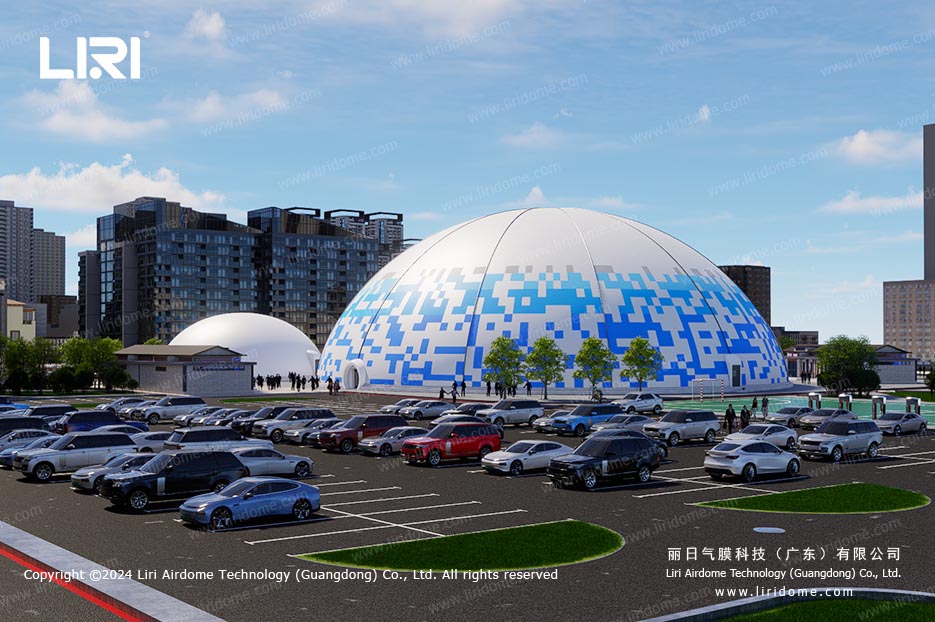- We are a professional air dome construction company, committed to providing new air dome structure buildings.
- Tel: +86 139 2339 9362 | 中文站
In recent years, due to the rapid growth of sports, events, exhibitions, industrial storage, and other sectors, there has been intense competition for resources in the market, leading to a rise in competition. From the establishment to the completion of a construction project, we must consider not only safety and cost, but also time cost and output ratio. In terms of large-scale building construction and application, the rapidly emerging air-supported structure industry is emerging, which has obvious advantages over traditional buildings.
1. Lightweight material
The air-supported structure mainly uses lightweight materials, such as the 1000-1500gsm PVC membrane with PVDF surface. It has weather resistance, antifouling properties, processability, water resistance, light transmittance, and more. The structure is lightweight, reducing the building’s overall weight and the required foundation capacity. This simplifies the design and construction of the foundation.

2. Quick construction and flexible movement
The air-supported structure has the greatest advantages of short construction period, disassembly and secondary use. Breaking the conventional model of traditional buildings, the installation of air-supported structure is simple and fast, which greatly shortens the construction time compared with traditional buildings. Generally, the construction of the main structure can be completed in about one month. The air dome is easy to disassemble, assemble and relocate, and is highly adaptable. It can be rearranged or repurposed as needed to achieve effective reuse of resources.

3. Energy saving and eco-friendly
Membrane materials have good thermal insulation properties, effectively isolate the temperature difference between indoor and outdoor, and reduce energy consumption of air conditioning and heating systems. And the light transmittance of the membrane is also very good, making full use of natural lighting during the day and reducing the need for artificial lighting. The production and construction process of the membrane material has low noise, no environmental pollution, and no construction waste. The membrane material itself is harmless and recyclable, which is in line with the green building concept of sustainable development. Furthermore, the air-supported structure greatly reduces the consumption of building materials because of its beam-free and column-free structure supported by air pressure. At the same time, the internal intelligent constant temperature effectively reduces the energy consumption of air conditioning.

4. Security and stability
•Structural safety: The air-supported structure does not have high requirements on the load-bearing and topography of the site. Its interior is mainly supported by internal air pressure. There’s no beams and columns, easily achieving a structural span of 120 meters. It adopts an intelligent control system to maintain the difference in internal and external air pressure, usually 100 ~ 500 Pa, ensuring the stability of the building structure, effectively resisting wind and snow loads, and can withstand up to level 16 typhoons. Within the safe range, the greater the air pressure, the stronger the building’s ability to withstand wind and snow.
• Flame retardant and fireproof: The PVDF membrane material has a fireproof grade B1 and complies with the national fire protection standards for building materials to ensure building fire safety.
• Entrance and exit design: The main entrance adopts a modular design, which not only meets the entry and exit needs of people and vehicles, but also ensures the overall sealing and safety of the structure.

5. Economical cost
The construction cost of air-supported structure is low. It is mainly composed of basic system, membrane system, mechanical integration system, air conditioning system, lighting system, access control system, etc. Compared with traditional fixed building facilities such as gymnasiums and exhibition halls, air-supported structures The construction cost is usually only 30% to 70% of traditional buildings, significantly reducing the initial investment cost. It also has low maintenance costs, low daily energy consumption, and low long-term operating costs.
To sum up, air-supported structure is suitable for a variety of application scenarios, such as stadiums, exhibition halls, warehousing facilities, industrial workshops, etc., especially in projects that require rapid construction, cost saving or high environmental protection requirements.
Search
Projects
© 2025. All Rights Reserved.